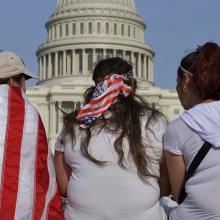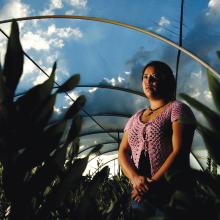Immigration
A Cincinnati area mosque announced it would join the burgeoning church sanctuary movement in the U.S., possibly becoming the first Islamic house of worship to do so.
The announcement came on the eve of the inauguration of President Donald J. Trump, who took a hard-line stance on immigration and proposed a national Muslim registry during his campaign.
Religion is increasingly viewed as highly politicized, not least due to the way that it is frequently covered in the news. Numerous studies have shown that news stories with emotional cues tend to both gain audience attention and prolong audience engagement.
It may therefore come as no surprise that online debates about religion are packed with emotional cues that evoke strong reactions from those who participate in them. This sets the stage for passionate online debates.
Currently there are an estimated 300 sanctuary states, counties, and cities across the U.S., but no model for sanctuary campuses. Calls for sanctuary campuses began in the wake of Donald Trump’s campaign pledges to repeal DACA and escalate deportations.
This idyllic immigrant story, that has become cliché in conversations of the “good” immigrant, shattered two weeks ago. I woke up to the fact that white America does not care about the well-being of my community. I woke up to the stench of white supremacy, which tells me that I will never be good enough to be fully American. I woke up in tears, because my dear friends who are undocumented immigrants, by no fault of their own, will suffer immensely under a Trump administration. I woke up longing to speak Spanish, to eat a whole Bandeja Paisa, and to feel what home feels like. I finally awoke to the reality that my brown body is a roadblock in white people’s project of making America great again.
Americans voted largely along the lines of race, education, and party identification. Nonwhites strongly preferred Clinton, while whites decisively chose Trump. Compared with past Republicans, the businessman received a stunning surge of votes from non-college-educated white voters.
None of this is surprising.
And yet the result upends so much conventional wisdom.
Even by this pope’s standards it was a bold move.
Francis, the spiritual leader of more than a billion Roman Catholics across the globe, this week traveled to Sweden, one of the most secularized countries in Europe, to take part in events marking 500 years since Martin Luther kickstarted the Protestant Reformation.
I am nervous for everyone. There is so much misinformation; the refugees of the Jungle and other camps like Isberg hear differing reports, which they then share among themselves. Tensions are growing because we, too, are given limited information, and can’t guarantee anything.
Would you trust someone who cannot give you any guarantees?
How can salvation be believed when we refuse to save refugees, or hope grasped when we deny it to immigrants, or justice pursued when we refuse it to the oppressed, or faith accepted when we don’t have faith in those different from us, or love known when we deny it to our neighbors, strangers, and even our enemies?

Image via Nadino/Shutterstock.com
As an immigrant woman and a Christian, I’ve loved the book of Ruth ever since I realized Ruth was an immigrant, welcomed into the family of God. And I’ve often been surprised by the interpretations of the Biblical story, in which Boaz is the hero and no one else has any agency. I find this odd because, as I read Ruth, what I see is that Boaz did nothing more heroic than exactly what was required by God’s law: He welcomed an immigrant from a neighboring community.

Image via Steve Pavey/Hope in Focus.
It has been a year since immigrant mothers made the impressive pilgrimage on foot from an immigrant detention center in Pennsylvania to the political seat of power in Washington, D.C. On Sept. 16, the women of last year’s 100 Women 100 Miles pilgrimage returned to the steps of the Supreme Court — singing, chanting, and praying for justice and mercy in the immigration system. Then, as part of an event organized by We Belong Together and The National Domestic Workers Alliance, they retraced a portion of their steps — a scaled-down anniversary pilgrimage, from the Supreme Court to the White House.

Image via Butsaya/Shutterstock.com
Four weeks ago many of us celebrated the news that the Department of Justice plans to end its use of for-profit prisons. But we then had to wrestle with the fact that this means nothing for migrant detention, which is the largest supplier of prison contracts for GEO and CCA — the top two corporations behind for-profit detention of immigrants of all ages: from babies to the elderly.
FOR IMMEDIATE RELEASE
Press contact: Michael Mershon, Director of Advocacy and Communications
Phone: 202-745-4654
Email: mmershon@sojo.net
We can no longer turn a blind eye to what profit margins do to prisoners, more and more of whom are from vulnerable populations. We are called to dismantle the corrupt justice system of mass incarceration. Ending private prison profiteering is a critical step towards restorative justice for all.
FOR IMMEDIATE RELEASE
Contact: Michael Mershon, Director of Advocacy and Communications
Phone: 202-745-4654
Email: mmershon@sojo.net
September 2, 2016
Faith leaders from different traditions condemn Trump’s immigration platform as immoral and an affront to the values of sacred texts

Image via Ryan Rodrick Beiler/Shutterstock.com
On Aug. 29, Secretary of Homeland Security Jeh Johnson announced that his department (which includes ICE) would also review the contracts of private companies contracted in its detention facilities. He cited the DOJ’s recent decision as a contributing factor to this investigation. We can only hope that their review will discover the inefficacies of private detention centers and prioritize the treatment of immigrants in their facilities.
Private prisons place profits over people, and I call on the DHS to end this inhumane practice, so that stories like my uncles do not repeat themselves.

image via tumblr / MAERIL
A young artist by the name of Maeril created a fantastic comic for anyone witnessing islamophobic harassment in public. It was published on her Tumblr and later on Facebook through her work with The Middle Eastern Feminist.

Chad Zuber / Shutterstock
ON MAY 1, 1986, a federal jury found nine church activists guilty of conspiracy to violate U.S. immigration laws for assisting Central American refugees. At our sentencing, I faced a possible 25-year prison sentence.
The “sanctuary trial” drew national attention; millions of Americans learned about the plight of Central American refugees and the church-led sanctuary movement to aid them. After a seven-month trial and our conviction, the judge suspended our sentence and gave us five years of probation.
In the 1980s, our case hinged on the fact that we knew that those arriving over the southern border were refugees from brutal wars in Guatemala and El Salvador. I had worked in Guatemala and in Guatemalan camps in southern Mexican. We placed refugees in communities of faith where people met them as real people and learned why they had fled. We defied U.S. immigration laws in order to protect life. We also challenged the Reagan administration’s support of brutal regimes in Guatemala and El Salvador.
Today, most of the non-Mexican undocumented immigrants coming over the border are from Guatemala, El Salvador, and Honduras. Many are unaccompanied minors or single adults with children. Many have legitimate asylum cases, but don’t have adequate legal representation.
The new sanctuary movement is addressing four key areas: First, assisting migrants when they arrive with basic needs and legal help. Diocesan Migrant Refugee Services in El Paso, Texas, is the largest provider of “Know Your Rights” information to refugees, particularly those staying in community-run hospitality houses along the border. Without the assistance of volunteers, usually church-affiliated, migrants would be on their own—or worse, detained in for-profit prisons.

Image via REUTERS/Jonathan Ernst/RNS
Donald Trump takes pride in rattling the GOP establishment, but he faces a major roadblock on the way to the White House.
Catholic voters, who have been key to picking the winning ticket in almost every modern election, reject Trump decisively. In 2012, President Obama won the overall Catholic vote 50 percent to 48 percent. Hillary Clinton now leads 56 percent to 39 percent, a sizable gap unlikely to close much by November.

Sarah Reynolds / Southern Poverty Law
HUMAN TRAFFICKING is one of the least morally controversial social justice issues of our time. Agreement that human trafficking is wrong and must end is widespread, if not completely unanimous. Yet when most people hear the term “human trafficking,” they envision sex trafficking: vivid images of young women forced to work in “massage parlors” and brothels, selling sex on the streets of major cities.
But human trafficking is broader than sex trafficking. U.S. law defines human trafficking through the legal categories of fraud, force, or coercion. In simple terms, human trafficking occurs when individuals lose control over their lives and are forced to work for nothing or next to nothing. Someone who has been trafficked does not have control over the terms and conditions of their employment; they can’t leave for fear that they or someone they care about will be harmed as a result.
So while trafficking certainly can take the form of sexual exploitation, it can also look like nannies or janitors, workers in slaughterhouses or meat-packing plants, people forced to work on factory assembly lines and rural farms. It takes place in both the formal and informal economies; it may involve adults and children.
When sex trafficking isn’t
Human trafficking hasn’t always been so tightly linked to sex trafficking. In the 1980s and 1990s, there were a number of nonprofits dedicated to combatting labor exploitation in all its forms. But when one of the first pieces of anti-trafficking legislation was proposed in 1999, its congressional sponsors wished to differentiate between sex-trafficking and other forms of labor exploitation. They “did not want ‘low-wage sweatshop issues’ to cloud the issue of human trafficking, which, they argued, was essentially about the sexual exploitation of women and girls and not about exploited labor more generally,” as Letitia Campbell and I wrote in 2014. Significantly revised anti-trafficking legislation was signed into law in late 2000.
Beginning in 2001, the George W. Bush administration implemented the new anti-trafficking law, making prostitution and sex-trafficking centerpieces of its gender policy. A 2002 National Security Presidential Directive on human trafficking called prostitution “inherently harmful and dehumanizing,” and the administration insisted that prostitution and sex-trafficking are linked phenomena.
I am a stranger in two strange lands. Born in the U.K. and an immigrant to the U.S., my understanding of self changed yesterday. As the U.K. voted to leave the EU and the U.S. Supreme Court’s tied decision left an appeals court block on President Obama’s executive order on immigration in place — my identity as an immigrant and a Briton changed.










